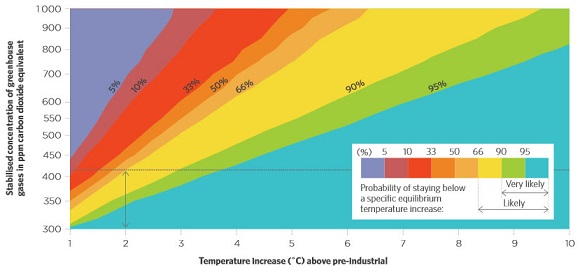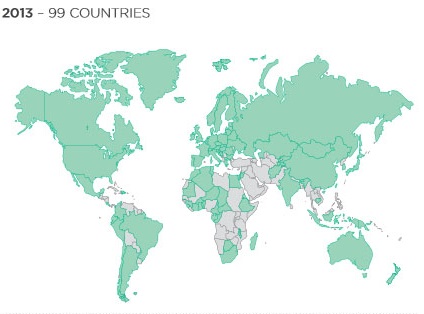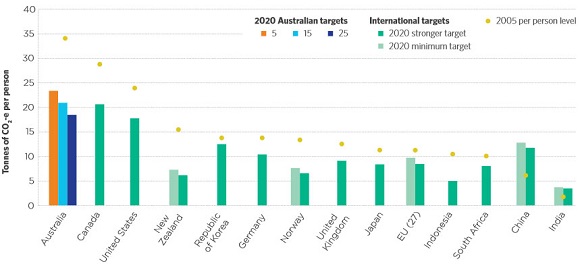In late February the Climate Change Authority published a Draft Report of its Targets and Progress Review.
The full draft report (all 265 pages) is downloadable from the first link above. Unfortunately I don’t have time to read all of it. Clive Hamilton at The Conversation has written an excellent overview.
Report summary
I’ve reproduced below the summary from the Executive Summary provided by the Authority, with some slight enhancements.
This Review can inform upcoming decisions on international commitments, guide long-term investment decision-making and inform the design of the Government’s Direct Action Plan.
The Authority’s views are grounded in science which says the world needs a long-term limit on emissions to stay below 2 degrees of warming and reduce risks of dangerous climate change. Australia also needs to take a long term view of emissions and set a 2050 emissions budget.
The Authority has also considered international action on climate change which shows a clear trend towards more ambitious action, although all countries need to do more.
The Authority has considered the economic implications of stronger targets and has concluded that it is possible to move to stronger targets at relatively small cost to the economy. The Authority’s draft recommendations seek to balance short term clarity and stability with longer term flexibility by recommending a single 2020 target and a trajectory range to 2030.
The Authority considers a 5 per cent target for 2020 to be inadequate because the Government’s [own] conditions [for moving beyond 5 per cent appear to have been met] and the pace of international action justifies us going further. [It] is inconsistent with action towards the 2 degrees goal and more ambitious targets might now be easier to achieve than earlier thought.
The Authority presents two targets for 2020 – 15 per cent and 25 per cent, with different trajectory ranges to 2030 [35 to 50 per cent and 40 to 50 per cent respectively].
Compared with 25 per cent, 15 per cent would require faster reductions later, and would use up more of the [carbon] budget sooner. [It] would place us in the middle of the pack on climate change action and would cost slightly less in the short term.
Australia can use international emissions reductions to help meet its target. While we have many domestic opportunities to reduce emissions, allowing international emissions reductions to be part of the mix can help lower costs. The Government should consider allowing the use of international emissions reductions to go beyond 5 per cent.
The Authority seeks feedback on this Draft report to inform its deliberations on final recommendations.(Emphasis added)
Clearly the Abbott Government will take no notice of the Review. In fact they have specifically reneged on the extended 5 to 25% range which had been bipartisan policy since 2009.
Emissions targets
In fact we may achieve better than 5% without too much government effort. In the Executive Summary (page 4 on the counter) we are told that during the 2008-2012 period we accrued 91MT CO2-e in credits under the Kyoto Protocol which can be carried forward. Then this:
Official projections made in 2012 indicated that 754 Mt CO2-e of emissions reductions were required in the period to 2020 to deliver the 5 per cent reduction target. On current estimates, the same level of emissions reductions would be equivalent to an 11 per cent reduction. Taking into account the Kyoto ‘carry over’ equivalent to 91 Mt CO2-e, this would imply a 14 per cent reduction by 2020.
The Authority appears to favour the 25% option, which yields a smoother path. It costs only $2.7 billion pa more (0.16% of GDP). With 15% you need accelerated effort after 2020.
My impression of the report is very favourable. Scientifically it appears sound. Economically they appear to have covered all bases, including trade implications.
The progress made to date has been because of changes in the balance within the economy from heavy manufacturing to services, a diminution in land clearing, and the impact of renewables and other factors in the electricity sector. Since 1990 our GDP has doubled while emissions have remained pretty much the same.
Stabilisation scenarios
The authority understands that there is considerable risk inherent in the 2% target stabilisation scenario and contemplated moving to 1.5°C. They stayed with 2°C because that is where the action is internationally. On page 42 they published this wondrous graph:

The source has Malte Meinshausen’s name on it, so it’s got to be OK.
The y axis gives stabilisation targets in terms of CO2 equivalent stabilisation. The x axis shows the matching probability of staying below any particular temperature rise. For inexplicable reasons the line is drawn at 415. In terms of CO2 equivalents we are now at 480. This gives us less than 33% chance of staying below 2°C and about a 10% chance of exceeding a civilisation threatening 4°C.
Moreover the climate sensitivity model used to create this graph is almost certainly conservative on the low side. Recent research indicates that the climate may be more sensitive to greenhouse gases than previously thought. As it stands the yellow band represents, I think, the extent of the compromise between rational science and science that makes concessions to politics.
To me the graph confirms the merits of the 350.org campaign, which gives an almost 95% chance of staying below 2°C. The Authority is aware that net negative emissions will probably be necessary later in this century.
International comparisons
Abbott and company are becoming quite annoying in suggesting that there is no action internationally. The Authority noted that there were 99 countries with ‘Copenhagen’ commitments covering over 80% of the planet’s emissions. This map shows the extent:

Then this graph shows how our targets fit with those of some of a selection of relevant countries.

Sorry I can’t get a clearer image. It’s on page 65 of the report. The y axis shows annual per capita CO2 equivalent emissions. The dots show the per capita emissions at 2005 levels. Notice that both China and India will increase per capita emissions. We are the clear outliers historically and in terms of where our targets will get us. Even at 25% we are only thereabouts with the US and Canada and well behind the pack.
The carbon budget approach
Especially pleasing was the Authority’s use of the carbon budget approach. They determined Australia’s budget as 10,100 MT CO2e for the period 2013 to 2150. A 15% target would use 4,324 MT by 2020, leaving only 5776 MT for the following 30 years. If we were really serious we would be going for 45 to 50% by 2020.
The review will have two values beyond the academic, in my view. Firstly, it should provide guidance for Labor and the Greens, looking forward to the time when the adults are back in charge. Secondly, I think other countries could look at the Authority’s use of the carbon budget approach. Its methodology is good although its level of ambition is still ordinary. Certainly it could stimulate other countries’ thinking about how to plan stabilisation of emissions.
Missed opportunity
Ben Eltham at New Matilda tells us that the LNP have responded with a press release from Greg Hunt containing a pack of lies. TheY could have used the report to:
axe the carbon price, keep Direct Action, triple our emissions reductions and change the carbon debate forever.
How would it do so? By buying carbon reductions on global markets. Because of the collapse of the European carbon market, credible carbon reductions are now for sale on international markets for as little 50 cents a tonne. The report thinks that Australia could buy the roughly 427 million tonnes of carbon reductions necessary to raise the target to 15 per cent for “between $210 and $850 million.”
Updates:
Firstly, Labor climate change spokesman Mark Butler has supported increasing the targets, has supported the CCA and it appears that Labor is willing to go to the 2016 election supporting a price on carbon.
Secondly, (actually from last year) research by the Climate Institute finds that emissions cuts of 11 to 19% will be achieved if the current laws are not changed.

Thank you for this Brian. It strengthens my growing resolve that all of us who are concerned about what the Abbott government is doing have a moral imperative to resistance.
I am heartened by the amount of peaceful non-violent resistance that does seem to be happening in Australia, with March in March, the Leard blockade, lock the gate and the other movements I’m reading about on twitter. I really hope there will be a huge concerted resistance to repeal of the clean energy package, and look forward to joining it when I get back to oz.
Thanks, Val.
I suspect the Climate Change Authority has had its funds taken away. I suspect also that Greg Hunt is on a fairly short leash.
I think the long term science message struggles when people are worried about what happens in the short term.
As I keep saying climate action can have very positive effects in the short term. For example, rooftop solar has driven power costs down and created jobs in places people want to live and……